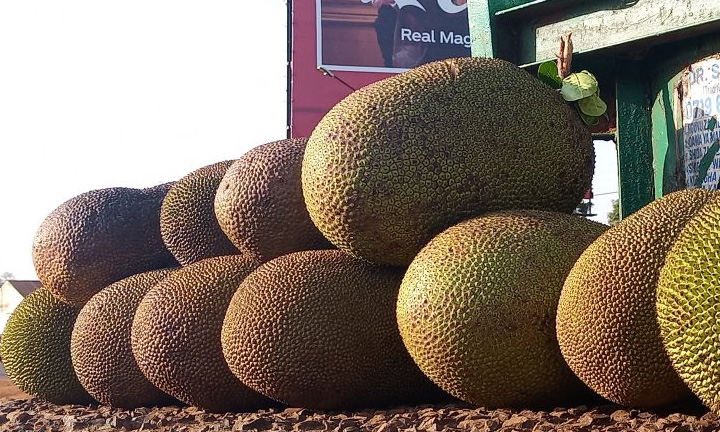SOURCE: Salome Alwanda, Kenya News
It is around 5.00 pm and the hot sun in Busia begins to cool down. I then decide to venture out just to find more about the jackfruit. My adventure takes me to a billboard structure along Busia – Korinda road where I find a group of people seated in a round table manner though there is no table at the centre.
Alongside them was James Wandera, extremely busy serving his clients with the little known fruit; the jackfruit famously known as ‘ofene’ by the natives.
Joseph Wandera cutting a piece of jack fruit to his clients. Even Primary school pupils flock to his place to have a bite. Photo by Salome Alwanda
Wandera, who is full of praise for his merchandise, seemingly knows more about this fruit and endears it to his clients.
“This fruit is called jackfruit or fenesi in Kiswahili,” he explains, adding that the fruit has 12 vitamins, fiber, proteins, and 25 medicinal values. He say that the fruit protects its consumers against diseases while at the same time providing them with a balanced diet.
“I have engaged in this business for the past four years and I get the fruits from Mundka Sub location,” he says, adding that there are some plantations within the area alongside individual farmers having a few trees in their homesteads.
Wandera further says that his clients are mostly from the locality and consumed the fruit in small pieces as per their financial muscles. “There is a certain investor who came to this county sometimes back and engaged some youth in stem counting the jack fruit trees across the county,” he says adding that they totaled more than 600,700 trees.
He at the same time disclosed that the investor wanted at least 1 million stems and thus urged the locals to plant more. “We do not plant these raw seeds but purchase already germinated seedlings,” he says, adding that it is one of the traditional trees brought to the region by the first Indians who came to East Africa from Southern India, especially Sri Lanka.
Wandera even owns ten stems at his homestead and now appeals to the County Government to assist farmers by connecting them with potential clients in Nairobi so that they can source the fruit from farmers due to its bulkiness and transportation costs.
“This fruit is liked and consumed by many Indians in Nairobi but it is very costly for farmers to transport them there,” he says adding that transporting just one fruit costs around Sh400.
The trader further claims that the fruit has the ability to suppress cancer, adding that one of his neighbors healed from skin cancer after consuming dried jackfruit seeds. “The patient had been diagnosed with stage four of skin cancer but I sun dried some of these jack fruit seeds and he consumed it through drinks leading to his recovery,” he says.
Fred Omuse, one of the customers says that the fruit quells hunger and reduces gas in the stomach. “No matter how hungry you are, if you just eat a piece of this fruit worth Sh10, you only require drinking water then you become comfortable,’’ he says noting the fruit has no negative side effects.
Mohammed Salim, another customer, reiterated that the fruit was very rare across the county and was liked by a number of residents due to its natural sugar content and fiber which protects them from hunger after consuming just little portions.
Meanwhile, Busia County has established a policy dubbed Busia County Biodiversity Policy, whose clarion call is our heritage and our strength on the basis of development. The policy which covers the period of 2016 to 2023 aims at addressing nutrition concerns in the County despite it being endowed with rich flora and fauna.
“The stunting rate in the County is 22 percent and children below five lack micronutrients alongside hidden hunger where people do not get the micro nutrients and minerals,” indicates the report.
On the basis of the above, the county is promoting some of the traditional crops like guava, gooseberries and jack fruit.
The County is particularly promoting the jack fruit because it is ecologically adapted to the area and is very rich in sugar and carbohydrates, hence is an energy giving fruit most frequently consumed by school going children during lunch hour.
The County Government is yet to explore other uses of this fruit like production of sugar syrup, jack fruit pudding and flavoring other food items.
Scientifically, 100 grams of an edible portion of jack fruit has 72 percent water, 1.2 to 1.9 percent protein, 16 to 25 percent carbohydrates, 20 percent of sugar, some fiber and calcium, 27 grams of magnesium and 38 grams of phosphorus among other nutrients.
It is being promoted for nutritional purposes in addition to venturing into commercial entities. There is still much more to be done because even animals mill around places where this fruit is being sold so that they can eat the seeds.
Currently, the County does not have a structured planting material and most of the plants grow naturally. The County has plans to embark on promoting value addition instead of transporting the bulky fruit which is very costly.
The County is pondering extracting the edible parts of the fruit and prolonging its shelf life so that it can be transported to other areas but the major challenge is that the farmers have not formed groups so that they can minimize the cost of production hence get more profits.

